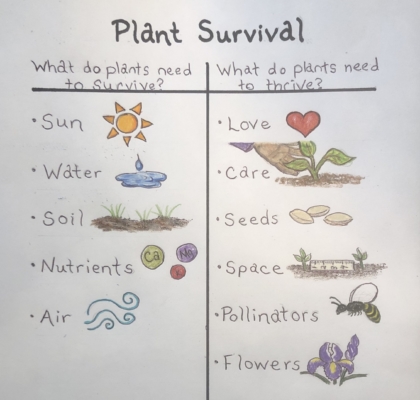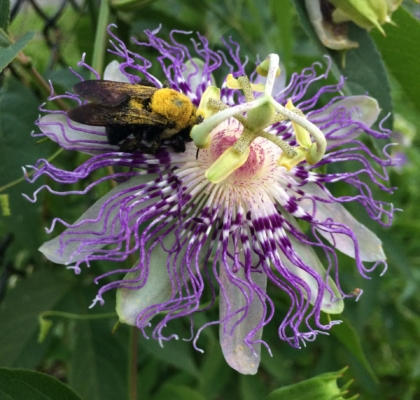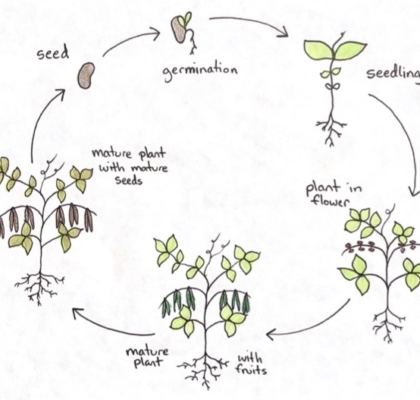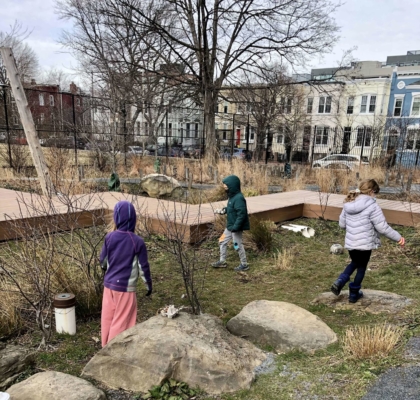These investigations are virtual adaptations of the FoodPrints Curriculum

Creating a Model Habitat
Investigation Description:
Students will create a model of a plant and its habitat. The teacher can create an example beforehand to help students understand the project.
Direct students to take out a piece of paper and drawing utensils. Ask students to think about a habitat that makes it difficult for a plant to survive (extreme cold or heat, little sun, poor soil, etc.). Students should draw a picture of that habitat. Next, students should come up with a plant (it can be totally imaginary!), but it must have an adaptation that will help it survive in this extreme habitat.
Students can get really creative with this. In the past, they’ve made arctic plants that can produce their own hot cocoa to stay warm. This should be fun! When students are finished with their drawings, offer them the opportunity to share their plants and to describe their adaptations.
Time: 15-20 minutes
Teacher materials: Example plant adaption drawing
Student materials: Piece of paper and writing or drawing utensils
This virtual investigation is adapted from: Kindergarten – A Recipe for Plant Survival

Jack and the Beanstalk: ELA & Science Connections
Investigation Description:
Explain that today’s lesson is about applying some lessons from a folktale to what we we can learn and discover in the garden.
Ask students to help you retell the original version of Jack and the Beanstalk. You can also all act out the story as you retell it. The brief summary of the story is below:
– Jack and his mother are very poor and, when they have no more food left, his mother tells Jack to sell the cow so they can buy food.
– On his way, Jack meets a stranger and trades the cow for a handful of magic beans. His mother is angry, but Jack plants the beans and they grow into an enormous beanstalk.
– Jack climbs the beanstalk and finds himself in the castle of an unfriendly giant. The giant senses Jack’s presence and cries, “Fee, fie, fo, fum, I smell the blood of an Englishman!”
– Jack survives by outwitting the giant and recovers many goods that had been stolen from his family, including an enchanted goose that lays golden eggs.
– Jack then escapes by chopping down the beanstalk. The giant, who is pursuing him, falls to his death and Jack and his family prosper.
Prompt students to discuss why they think this story about magical seeds was written and has been retold for so long, and if they can see any qualities of seeds that make them seem magical.
Time: 10-20 minutes
Teacher Materials: None
Student Materials: None
This virtual investigation is adapted from: 2nd Grade – The Magic of the Garden

Act It Out: The Life Cycle of a Bean Plant
Investigation Description:
Ask students, “What was magical about the beans in the story?” Part of the magic is how quickly the plant grew.
Explain that plants, like people, have life cycles. A bean, like all plants, starts life as a seed, then grows into a seedling with roots that can dig into the ground. With water, sunlight and nutrients, the seedling grows into a mature plant with flowers. After the fruit is ripe, it breaks open, and the seeds from the fruit are ready to become new plants.
You can deepen the conversation by discussing how even though different plants take different amounts of time to grow — some last only a season, others closer to a year, and some, like trees, last for MANY years — they all go through a similar sequence: sprout, leaves, flowers, some have fruits, all have seeds.
To keep students engaged, you can ask them to act out the different stages. “Curl up like you are a little seed that just got planted/dropped and you are waiting for the soil to warm up and get a drink of water…. stretch up and out reaching the sun, etc!”
If possible, you can prepare a pea or bean in a few of its different stages before class to share with students (dried seed, germination, seedling, etc)
Time: 10-15 minutes
Teacher Materials: Bean plant in different stages of life cycle (optional)
Student Materials: None
This virtual investigation is adapted from: 2nd Grade – The Magic of the Garden

The Ecosystem Outside My Window
Investigation Description:
In this investigation, students will observe the ecosystem outside of their window.
Review with students that an ecosystem is a community of living things, nonliving things, and once living things interacting with their environment. Tell students that they will take 5-10 minutes to write down and/or draw the living, nonliving, and once living things they see right outside of their window. You can show them your own example to help them get started.
Afterwards discuss whether or not they would consider the environment they observed, an ecosystem, why or why not?
Time: 5-10minutes
Teacher Materials: Example list and/or drawing of the living, non-living, and once-living things outside of your window
Student Materials: Piece of paper and writing or drawing utensils
This virtual investigation is adapted from: 3rd Grade – The Garden Ecosystem
